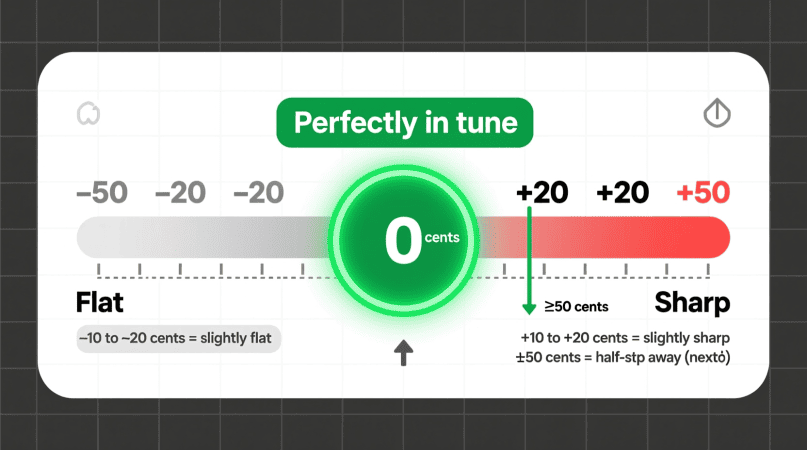
If you’ve used a pitch detector, you’ve seen the ±cents display under the note and frequency. But what do those numbers really mean? And how can you use them to improve your tuning or singing?
This guide explains what ±cents are, how to read them, and practical ways to use them for better accuracy.
What Does ±Cents Mean?
Pitch detectors measure pitch accuracy in cents — tiny units dividing each semitone (the distance between two notes) into 100 equal parts.
- 0¢ = perfectly in tune
- +¢ = sharp (above the target note)
- −¢ = flat (below the target note)
So, if your detector shows A4, +8¢, it means you’re 8 cents sharp — slightly above the ideal frequency.
Quick Reference Table
| ±Cents Reading | Intonation Status | What to Do |
|---|---|---|
| 0–5¢ | Excellent | Keep it steady |
| 6–15¢ | Slightly flat/sharp | Small correction needed |
| 16–30¢ | Off-pitch | Reset, check breath/posture |
| >30¢ | Far off | Re-center before practicing |
How to Use ±Cents in Practice
1. Singing Practice
- Start with single vowels (“ah,” “oo”) for 3–5 seconds.
- Aim for 0–5¢ stability before adding dynamics or vibrato.
- Use the Voice Pitch Analyzer for vocal-specific feedback.
2. Instrument Tuning
- Pluck one string or play one note at a time.
- Adjust tuning pegs until the reading stabilizes near 0¢.
- For quick string-by-string setups, see Instrument Quick Starts.
3. Intonation Training
- Play or sing scales slowly.
- Watch the ±cents drift on each note.
- Over time, your ear learns to center itself naturally.
Common Mistakes to Avoid
- Chords or complex sounds: Pitch detectors work best with single notes.
- Moving notes too quickly: Hold steady for 2–3 seconds to lock the reading.
- Ignoring calibration: Check A4 = 440 Hz vs 442 Hz if needed.
For high-register challenges, read Whistle & High Register Detection Tips for accurate setup advice.
FAQs
1. How accurate is ±cents measurement?
Most detectors read within ±3 cents in quiet conditions with a good mic.
2. Does ±cents replace tuners?
No, it adds detail. Tuners show “in tune/out of tune,” while ±cents show how close.
3. Can I use ±cents for choir tuning?
Yes. Many choirs aim for ±5¢ precision on key notes.
4. Why does ±cents flicker?
Noise, mic issues, or unstable notes cause flicker. See Pitch Flicker Causes & Fixes for solutions.
Pitch Detector is a project by Ornella, blending audio engineering and web technology to deliver precise, real-time pitch detection through your browser. Designed for musicians, producers, and learners who want fast, accurate tuning without installing any software.
